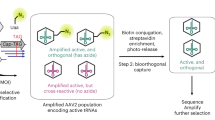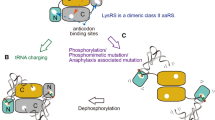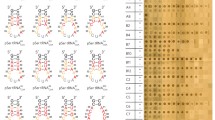Abstract
Mammalian aspartyl-tRNA synthetase (DRS) occurs in a multi-enzyme complex of aminoacyl-tRNA synthetases, while DRS exists as free soluble enzymes in bacteria and yeast. The properties of human DRS transient expressed in COS cells were examined. After transfection of COS cells with the recombinant plasmids pSVL-63 that contained hDRS cDNA coding and non-conding sequences, and pSV-hDRS where the non-coding sequences were deleted, DRS in the transfected COS cells significantly increased compared to mock transfected cells. COS cells transfected with pSV-hDRSΔ32 that contained N-terminal 32 residue-coding sequence deleted hDRS cDNA showed no increase in DRS activity. Northern blot analysis showed that concentrations of corresponding mRNAs of hDRS and hDRSΔ32 were greatly enhanced in transfected cells. The increases in the level of the transcripts were much higher than those of the corresponding proteins. Gel filtration analysis showed that hDRS in pSV-hDRS transfected cells expressed as a low molecular weight form of hDRS and pSV-hDRSΔ32 transfected cells did not. Epitope tagging and indirect immunofluorescence microscopy was used to localize hDRS. Both hDRSmyc and hDRSΔ32myc were localized in the cytoplasm and showed diffused patterns. These results showed that hDRS has little tendency to aggregatein vivo and suggested that the N-terminal extension in hDRS was not involved in the expression and sub-cellular localization of hDRS, but may play a role in the maintenance of enzymatic activity of hDRS in COS cells.
Similar content being viewed by others
References
Schimmel P, D Soll: Aminoacyl-tRNA Synthetase: General Features and Recognition of tRNA. Ann Rev Biochem 48: 601–648, 1979
Ferber S, A Chiechanover: Role of arginine-tRNA in protein degradation by the ubiquitin pathway. Nature 326: 808–811, 1987
Moore P A, D W Jayne, D C Oxender A role for aminoacyl-tRNA synthetases in the regulation of amino acid transport in mammalian cell lines. J Biol Chem 252: 7427–7430, 1977
Zamecnik P C: Diadenosine 5′5′''-P1, P4 tetraphosphate (ApppA): Its role in cellular metabolism Anal Biochem 134: 1–10, 1983
Mathews M B, R M Berstein: Myositis autoantibody inhibits histidyl-tRNA synthetase: A model for autoimmunity. Nature 304: 177–179, 1983
Deutscher M P: Eukaryotic aminoacyl-tRNA synthetase complex. Suggestions for its structure and function. J Cell Biol 99: 373–377, 1984
Mirande M:Aminoacyl-tRNA synthetase family from prokaryotes and eukaryotes: structural domains and their implications. Prog Nucleic Acid Res Mol Biol 40: 95–142, 1991
Yang D C H, J V Garcia, Y D Johnson and S Wahab: Multi-enzyme complexes of mammalian aminoacyl-tRNA synthetases. Current Topics in Cellular Regulation 26: 325–335, 1985
Motorin Y A, A D Wolfson A F, Orlovsdy and K L Gladilin: Mammalian VRS forms a complex with first elongation factor. FEBS Lett 238: 262–264, 1988
Bec G, P Kerjan, X D Zha and J P Waller: Valyl-tRNA synthetase from rabbit liver. I. Purification as a heterotypic complex in association with elongation factor 1. J Biol Chem 264: 21131–21137, 1989
Dang C V and D C H Yang: Disassembly and gross structure of particulate aminoacyl-tRNA synthetases from rat liver. J Biol Chem 254: 5350–5356, 1979
Lazard M, M Mirande and J P Waller: Purification and Charac-terization of the Isoleucyl-tRNA synthetase component from the high-molecular-weight complex from sheep liver: A hydrophobic metalloprotein. Biochemistry 24: 5099–5106, 1985
Kellermann O, A Brevet, H Tonetti and J P Waller: Methionyl-tRNA synthetase from sheep liver. Purification of a fully active monomer derived from high molecular weight complexes by trypsin treatment. Eur J Biochem 88: 205–210, 1978
Eriani G, G Dirheimer and J Gangloff: Aspartyl-tRNA synthetase from E. coli: cloning and characterization of the gene, homologies of its translated amino acid sequence with asparaginyl- and lysyl-tRNA synthetases. Nucleic Acid Res 18: 7109–7117, 1990
Sellami M, G Prevost, J Bonnet, G Dirheimer and J Gangloff: Isolation and characterization of yeast aspartyl-tRNA synthetase gene. Gene (Amst.) 40: 349–352, 1986
Mirande M and J P Waller: Molecular cloning and primary structure of cDNA encoding the catalytic domain of rat liver aspartyl-tRNA synthetase. J Biol Chem 264: 842–847 (1989)
Yang D C H and A Jacobo-Molina Organization of Mammalian Protein Biosynthetic Machinery Revealed from the Aminoacyl-tRNA Synthetase Complex. Structural and Organizational Aspects of Metabolic Regulation, P.A. Srere, M.E. Jones, and C.K. Mathews. Vol. 133. 1990. N. Y., Wiley-Liss, 199–214
Jacobo-Molina A, R Peterson and D C H Yang cDNA sequence, predicted primary structure and evolving amphiphilic helix of human aspartyl-tRNA synthetase. J Biol Chem 264: 16608–16612, 1989
Mirande M, M Lazard, R Martinez and M T Latreille. Engineering mammalian aspartyl-tRNA synthetase to probe structural features mediating its association with the multisynthetase complex. Eur J Biochem 203: 459–466, 1992
Escalante C and D C H Yang: Expression of human aspartyl-tRNA synthetase in Escherichia coli: Functional analysis of the N-terminal putative amphiphilic helix. J Biol Chem 268: 6014–6023, 1993
Natsoulis G, F Hilger and G R Fink. The HTSI gene encodes both the cytoplasmic and mitochondrial histidyl-tRNA synthetase of S. cerevisiae. Cell 46: 235–243, 1986
Schatz G, R A Butow: How are proteins imported into mitrochondria? Cell 32: 316–318, 1983
Blobel G: Intracellular protein topogenesis. Proc Nat Acad Sci USA 77: 1496–1500, 1980
Bose K K, N K Chatterjee and N K Gupta: Fractionation of rabbit liver methionyl-tRNA species. Methods Enzymoll 29: 522–529, 1974
Sambrook J, E F Fritsch and T Maniatis Molecular Cloning: A Laboratory Manual. 2nd Ed. ed. 1989, N. Y., Cold Spring Harbor Laboratory Press
Sanger F, S Nicklen and A R Coulson: DNA sequencing with chainterminating inhibitors. Proc Nat Acad Sci USA 74: 5463–5467, 1977
Chen C, and C Okayama: Biotechniques 6: 632–635, 1987
Kato G J, J Garret, M Villa-Garcia and C V Dang: An amino-terminal c-myc domain required for neoplastic transformation activates transcription. Mol Cell Biol 10: 5914–5920, 1990
Dang C V, D C H Yang and T D Pollard: Association of Methyionyl-tRNA Synthetase with Detergent-insoluble Components of the Rough Endoplasmic Reticulum. J Cell Biol 96: 1138–1147, 1983
Chirgwin J M, R J Przyhyla, R J MacDonald and W J Rutten: Isolation of biologically active ribonucleic acid from sources enriched in ribonuclease. Biochem 18: 5294–5299, 1979
Lusky M and M Botchan: Inhibition of SV 40 replication in simian cells by specific pBR322 DNA sequences. Nature 293: 79–81 (1981)
Munro S and H R Pelham: Use of peptide tagging to detect proteins expressed from cloned genes: deletion mapping functional domains of Drosophila hsp 70. EMBO J 3: 3087–3093, 1984
Kozak: Compilation and analysis of sequences upstream from the translational start site in eukaryotic mRNAs. Nucleic Acid Res 12: 857–872 1984
Springer M, J A Plumbridge, J S Butter, M Graffe, J Dondon, J F Mayaux, G Fayat, et al.: Autogenous control of E. coli threonyl-tRNA synthetase expression in vivo. J Mol Biol 185: 93–104, 1985
Dehlinger P J and R T Schimke: Biochem Biophys Res Comm 40: 1473–1481, 1970
Eriani G, G Prevost, D Kern, P Vincendon, G Dirheimer and J Gangloff: Cytoplasmic aspartyl-tRNA synthetase from Saccharomyces cerevisiae. Study of its functional organization by deletion analysis. Eur J Biochem 200: 337–343, 1991
Negrutskii B S and M P Deutscher: Channeling of aminoacyl-tRNA for protein synthesis in vivo. Proc Natl Acad Sci 88: 4991–4995, 1991
Author information
Authors and Affiliations
Rights and permissions
About this article
Cite this article
Escalante, C., Qasba, P.K. & Yang, D.C.H. Expression of human aspartyl-tRNA synthetase in COS cells. Mol Cell Biochem 140, 55–63 (1994). https://doi.org/10.1007/BF00928366
Received:
Accepted:
Issue Date:
DOI: https://doi.org/10.1007/BF00928366




